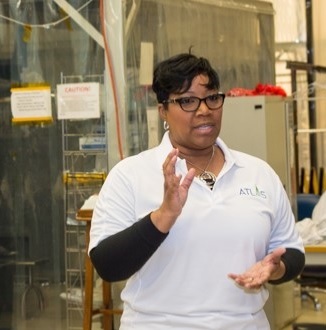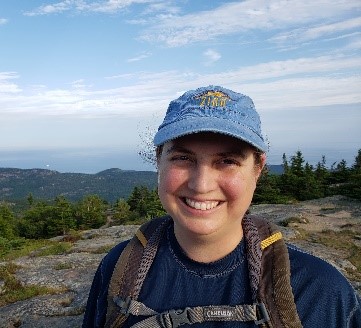Biographies:
Cathy Richardson has over 25 years of experience in program/project management and space flight instrument development at Goddard Space Flight Center (GSFC).
Cathy currently serves as the Program Manager of NASA's Earth Systematic Missions Program, responsible for the management and coordination of all systematic Earth
observation missions and the Reimbursable Projects Program for U.S. partner agency funded projects. In this role, she also serves as the Associate Director of Flight
Projects for Earth Science Projects at GSFC supervising GSFC project managers. She provides oversight for multiple projects in all phases of formulation and implementation,
including mission studies and operations. She coordinates international and interagency partnerships and collaborates with other NASA field centers. She developed and is
continuing to refine a number of critical tools to provide programmatic assessments of technical, cost, and schedule performance that allow in-depth forecasting and
trending of project performance. She also focuses on assessing cross cutting technical issues and risks across Earth science projects and provides regular reporting to
both GSFC management and NASA Headquarters.
She has in-depth experience with GSFC in-house instrument development, serving as the Instrument Project Manager of the Advanced Topographic Laser Altimeter System, the largest and most complex
instrument built by GSFC, from its Preliminary Design Review through environmental testing. Through her leadership, a comprehensive rebaseline was performed, resulting in a new commitment that was met
by the instrument delivery. Cathy also served as the in-house Instrument Manager for the Thermal Infrared Sensor, leading its development from inception to delivery, meeting all technical and programmatic
commitments. Additionally, Cathy was the Instrument Manager for two contracted instruments, the Space Environment In-Situ Suite and the Solar Imaging Suite, for the Geostationary Operational Environmental
Satellite (GOES-R) series during its formulation phase; and for two contracted instrument series, the High Resolution Infrared Radiation Sounder instruments and the Advanced High Resolution Radiometers,
for the Polar Orbiting Operational Environmental Satellite project. She also previously served as the Chief of the Instrument Management and Systems Office.
Cathy started her career as a structural analyst for multiple space flight projects supporting GSFC, the Naval Research Lab, and Johns Hopkins University. She holds a Master's Degree in Mechanical
Engineering from the University of Maryland and received her Bachelor's Degree in Aerospace Engineering from the Virginia Polytechnic Institute and State University. She was awarded the NASA Outstanding
Leadership Medal in 2012 and the NASA Exceptional Service Medal in 2016 and 2019.
Donya Douglas-Bradshaw
Education - BS Mechanical Engineering from University of Maryland
9 Semester hours towards a Masters in Engineering Management at John Hopkins University
Donya Douglas-Bradshaw has twenty-nine years of experience at NASA Goddard, Wallops, and Headquarters as a thermal systems engineer, technologist, product development lead,
thermal analyst, experiment manager, principal and co-investigator for technology developments, instrument systems engineer, line manager, Instrument Project Manager, and
Deputy Project Manager. She has experience across the entire project lifecycle from concept development to decommissioning and on in-house and out-of-house projects. She is
currently the Project Manager Lucy, a mission to the Jupiter trojan asteroids. Prior to Lucy, she was the Project Manager for the ICESat-2 ATLAS instrument, ATLAS, which is the
largest and most technologically advanced instrument built in-house at Goddard, successfully launched aboard ICESat-2 on September 15, 2018.
Donya's past projects include, but are not limited to: Space Technology 5 (ST-5), Earth Observing Satellite (EOS) AQUA and TERRA, ICESat GLAS, HST, SWIFT, Space Technology 8
(ST8), GAS Cans, Hitchhiker Payloads (CAPL1 & 2, CRYOTSU), and MetOP POES. She has worked with all NASA Centers, JPL, APL, Department of Defense, the Pentagon, NSA, NOAA, NRO, OCE,
ESA, and aerospace companies such as Orbital ATK, NGIS, Sandia National Labs, SGT, Ball Aerospace, and Lockheed Martin. Throughout her career she has authored or co-authored over
20 publications in research and development on Capillary Pumped Loops, Loop Heat Pipes, and Variable Emittance Coatings. She has won several awards for Engineering, Leadership and
Outreach (RH Goddard, Agency Honor Awards, and NASA Medals). Donya has been featured in national magazines such as Upscale Magazine and Black Enterprise. She was also listed as
one of THEGRIO.COM Top 100 History Makers in the Making.
Donya is married to Myron Bradshaw and together they have a total of five children ranging in ages from 17 to 30. Outside of work, she enjoys researching her family history
and has assembled a family tree of more than 10,000 people and dating back to the early 1800s.
Dave Everett is currently the Head of the Instrument and Payload Systems Engineering Branch at Goddard Space Flight Center, where he supervises an organization of about 50 instrument systems engineers.
In his 29 years at NASA, he has led the design, build, and launch of four spacecraft, and he was a key player during the launch of three others. His most recent mission, OSIRIS-REx, is on its way to
return a sample from the asteroid Bennu. His previous mission, the Lunar Reconnaissance Orbiter (LRO), continues to collect high-resolution science data at the moon. As the Project Systems Engineer on
OSIRIS-REx and the Mission Systems Engineer on LRO, Mr. Everett led the technical effort from early design through on-orbit operations. In his previous role as Chief Engineer for the Instrument Systems and
Technology Division, he oversaw the technical efforts of over 150 engineers working with key technologies in optics, cryogenics, detectors, lasers, and radio-frequency instruments.
David Everett has received 44 individual awards, 40 group awards, and a patent for his efforts at NASA; he has published 21 papers; and he co-edited (and wrote the spacecraft design chapter for) the book Space Mission Engineering:
The New SMAD. He earned a BSEE summa cum laude, at Virginia Tech in 1986 and a MSEE at the University of Maryland in 1989. Before he joined NASA in 1991, Mr. Everett worked at Westinghouse Electric Corporation in a radar-receiver
design group where he was awarded two patents for his designs of RF circuits.
Julie Van Campen is the James Webb Space Telescope Deputy Commissioning Manager and Lead Systems Engineer for the Integrated Science Instrument Module (ISIM) of NASA's Goddard
Space Flight Center in Greenbelt, Md.
In her role on Webb, Van Campen oversees all of the operational, mechanical, thermal, optical and electrical interfaces between the subsystems and the ISIM, which is the
integrated system of all four science instruments with shared support systems and oversees the overall commissioning plan for the Observatory.
As a systems engineer, she works to ensure her team's success. She focuses on communicating, collaborating and coordinating to find solutions to technical and organizational
challenges. Her involvement with the Webb project extends back to 2003 when she joined the Webb team as an Integration and Test systems engineer. She developed the ISIM Requirements
documents for the ISIM System Requirements Review. Van Campen then transitioned to be the ISIM's Instrument Systems Engineer on both the NIRCam and NIRSpec instruments until
they were delivered to ISIM. She then served as the ISIM Deputy, then Lead System Engineer. She transitioned to the Deputy Mission Operations Manager position, then to the
Deputy Commissioning Manager position.
Growing up in Bucks County, Pennsylvania, she was involved in building projects with her dad and worked summers during high school at a horse farm.
Van Campen's love of diving into challenging projects and desire to push boundaries in science drove her to study engineering. She received her bachelor's and master's degrees
in mechanical engineering from Lehigh University and Johns Hopkins University.
In her spare time, she works as a volunteer park ranger for the Maryland Park Service maintaining trails, buildings and other structures. She enjoys backpacking and is currently working on hiking the Appalachian trail in sections.



